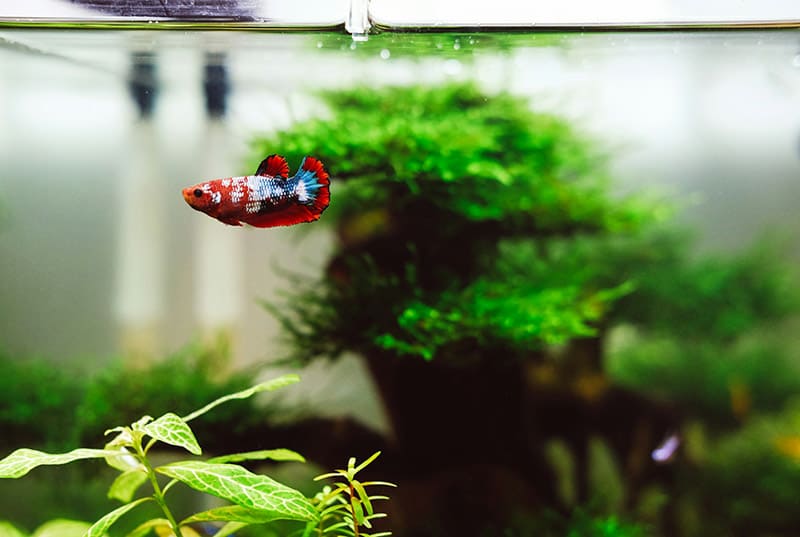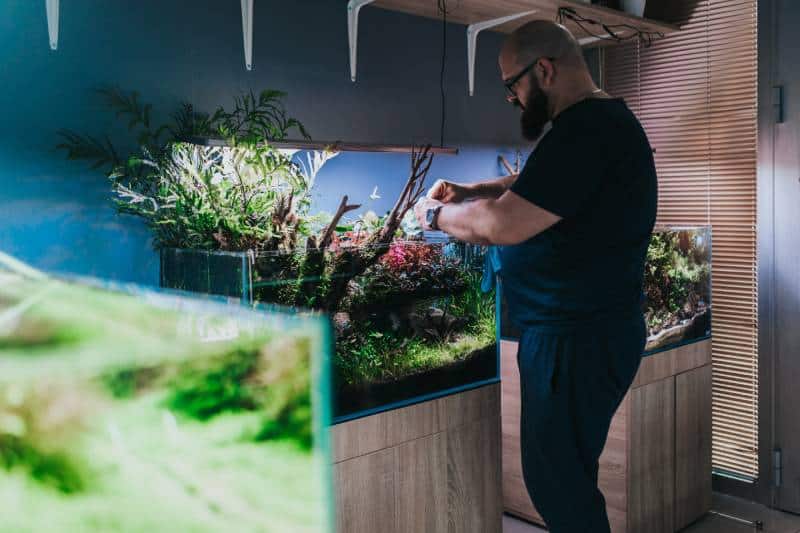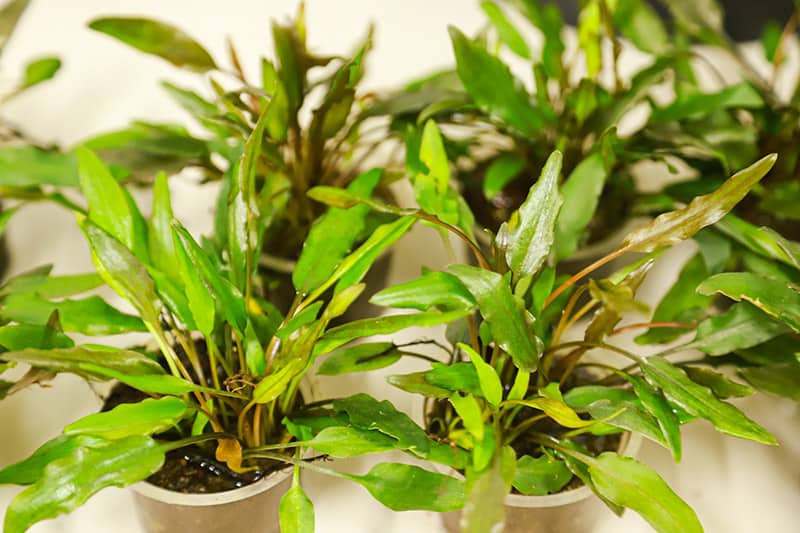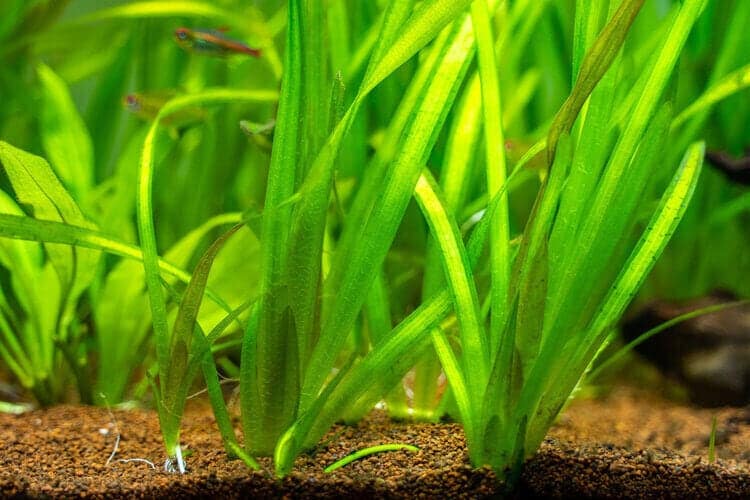Using freshwater plants to craft a beautiful aquarium is lots of fun, and is a very rewarding and creative experience.
An attractive aquarium can be even more stunning using live aquarium plants. Plants make attractive ornamentation and they help to keep the water quality of the aquarium balanced.
Along with beauty and stability, an aquarium aquascape will also create a natural and peaceful aquatic environment.
Three steps for successful planted aquariums There are several things to consider when designing planted aquariums.
Step 1: Aquarium Design – The Aquascape Aquarium
The first consideration is the design phase. This is your personal and unique aquarium aquascape setup. The aquarium design step is where you determine what you would like your tank will look like.
Step 2: Selecting the Types of Plants
Once you’ve decided on the overall look of the aquascape aquarium, your next step is to learn a bit about aquarium plants to decide what types of plants you’d like to have.
The types of aquatic plants include rosette plants and stem plants (many of which are flowering plants), ferns and moss (rhizomes), aquarium plant bulbs, tubers, and floating Plants.
Step 3: Adding Plants to the Aquarium
The third step includes determining the type of environment that is necessary in order for your plants to thrive, preparing the aquarium for your plants, and finally adding plants to aquarium!
Carefully planning during these three initial steps will help you create a beautiful and rewarding planted aquarium.

Aquarium Design – The Aquascape Aquarium
Designing a planted aquarium: Planning what your aquarium will look like is one of the funnest parts. You may want to fashion your aquarium aquascape setup after a natural occurring aquatic habitat. These are referred to as ‘Biotope’ aquariums. They replicate a natural water way, such the Amazon Basin for an Amazon biotope, and incorporate plants and fish found in those habitats. Or you may simply want to mix and match plants and fish in your own particular pleasing manner.
No matter what size of an aquarium you are designing for, the simplest way to plan, is to think about the tank as having three parts running vertically across the bottom of the tank. Visually divide the space into a background area, a middle or mid-ground area, and a foreground. Along with these planting areas on the bottom, there is also the top or surface area. On the surface you can add floating plants.
Keep in mind the needs or your fish, they like to have places to hide but also need open areas for swimming. To determine which types of plants can go in each area, read about each plant you are considering to determine what height and width it will reach, and how much it will spread out as grows and propagates. Here are some design considerations for each area of your aquarium:
- Background Area: This is the backdrop for your tank. Aquarium plants that do best in this area are those that grow tall. Rosette plants such as the sword plants, Vallisneria, and Water Onions work well here. Some of the ferns like the Java Fern, and some of the stem plants like Anacharis, Hornwort, and Cabomba can also be used. You need to be careful that the plants you choose for height don’t also bush out too much. unless you want plants that will fill in both the background area as well as the middle area.
- MIddle Area: The mid-ground area of your aquarium is the primary focal area. Careful placement of plants in this area is important for a balanced design. It is also important to include open swimming space for your fish in this area. Consider low-growing and moderate height plants. Those that bush out can be perfect, as they will have plenty of room to grow and can become the main attraction. Stem plants work great for this area, as many of them are moderate in height as well as have some bushyness to them. There are also fern plants and rosette plants that can work well.
- Foreground: Plants in the foreground need to be low-growing so they don’t block the view of rest of your aquarium. They can be individual plants or ground cover type plants. Rosettes such as the Dwarf Lilly, Dwarf Anubias, Micro-Sword Grass, and some of the Cryptocoryne’s work real well. Stem plants like the Fountain Plant and the Japanese Rush are great individual plants for the foreground and can also be used as additional focal points.
- Surface Area: Plants on the surface or top of the aquarium are often free floating plants that don’t need to root in the aquarum substrate. However, some of the water plants growing out of the substrate will grow tall and also spread across the surface. These plants are great places for fish fry to hide in, but you need to be careful to not let surface plants obsure the light necessary to the other plants or it can restrict their plant growth.
Selecting the Types of Plants
Selecting your plants: When deciding what plants to put in your aquarium, you should take into account a few basic about aquarium plants.
- Plants characteristics: First, research how large different plants can get and their water requirements (i.e. pH, temperature, water hardness, light, etc). Obviously, you don’t want to buy large plants for a small aquarium or small plants for a large aquarium. You also want to try to buy plants that have similar water requirements so that they will all thrive equally well in the environment that is provided. Also, keep in mind that you may not want fast-growing plants together with slow-growing plants because faster growing plants can use up the nutrients so quickly that the slower growing plants don’t receive adequate nutrients.
- Compatibility: Another consideration is what fish and plants are compatible. Once again, you want to make sure that the water requirements are similar for both the fish and plants so that it is not difficult to meet the needs of all the organisms in the aquarium.
- Visual effects: To create an attractive aquarium design, try choosing plants that have different colors and structures. You can include aquarium plants with varying colors, such as red and green plants. Visual interest is also added by varying between broad leaf and skinny leaf plants, as well as varying between tall and wide plants. Arrange the plants to create focal points and backdrops. Using each of the three areas, the foreground, mid ground, background, and even floating plants on the surface area, will help contribute to the visual attractiveness of the aquarium.
Purchasing your plants: When actually purchasing the plants, try to find healthy, young ones. Signs that they are not healthy include brown and yellow leaves, holey or transparent leaves, missing leaves, bent stems, and white or damaged roots.
Most plants sold in pet stores are in pots or are sold in floating bunches. For transport home, they should be placed in plastic bags with air and moisture, or wrapped in moist newspapers. This will keep them from drying out and getting damaged.

Adding Plants to the Aquarium
Starting a new planted aquarium: When first starting up a new aquarium it is best to choose hardy plants that root quickly because the biological system is not yet established and broken in. Plants that are fairly sensitive will have a hard time and may die easily.
Algae also tends to grow quickly at first before the aquarium is broken in. Hardy plants are better able to cope with this fast algae growth. It is a good idea to purchase algae eaters immediately as well to help keep down the algal growth.
After the aquarium is effectively broken-in, about 4-6 weeks, the hardy plants can be replaced with the less hardy plants. The more sensitive plants will have a much easier time in an aquarium that is already established.
For more information on setting up a planted aquarium see: Setting Up a Planted Aquarium
Preparing your plants for the aquarium:
Once home, thoroughly rinse off the plants. Take them out of any containers, remove rubber bands, and cut off any dead roots, stems, and leaves.
Often new plants will contain snails. For normal aquariums it is not necessary to remove them, if however you are using a slow-release fertilizer, you will want to remove any Malayan snails. If you plan on having a strictly plant aquarium, you will want to remove all snails.

Planting your aquarium
In new aquariums make sure the water is around room temperature before planting. Cold water shocks and stresses most aquarium plants. Here’s some basic information about aquarium plants:
- Rosette Plants: If there is a lot of root growth, cut up to half of them off because this stimulates new root growth. Then simply make a hole with your finger in the substrate and place the plant firmly in it. Fill in the hole and make sure that a small part of the root is visible above the substrate.
- Stem Plants:You don’t usually want to plant stem plants because their roots grow at their nodes and because they are more sensitive. So simply by clipping them to the ground or tying them to a piece of wood or rock with some thread, and then allowing them to root by themselves is a good alternative.
- Ferns and Mosses: For rhizomes, make sure that the roots are planted as deeply as possible, at an angle, and with no roots above the substrate.
- Bulbs and Tubers: Aquarium plant bulbs and tubers should have about half of the bulb covered by the substrate.
- Floating Plants: Floating plants do not need to be planted at all, they should just be placed on top of the water, without trimming their roots.
Leave room between newly planted specimens so that they will have room to grow. A good idea is to provide newly placed plants with nutrient tablets. Place the tablets in the soil right next to, or below their roots. This will provide them with an immediate source of nutrients.
Featured Image Credit: Joan Carles Juarez, Shutterstock
